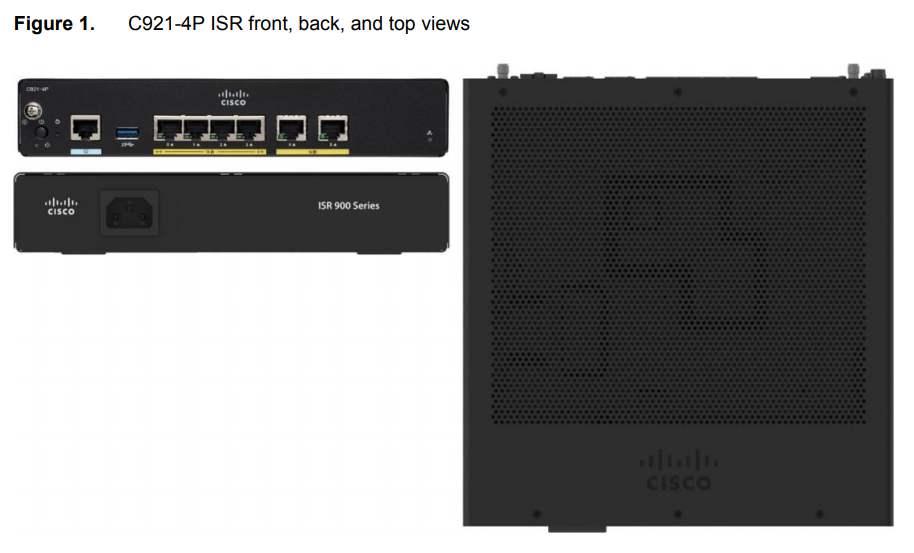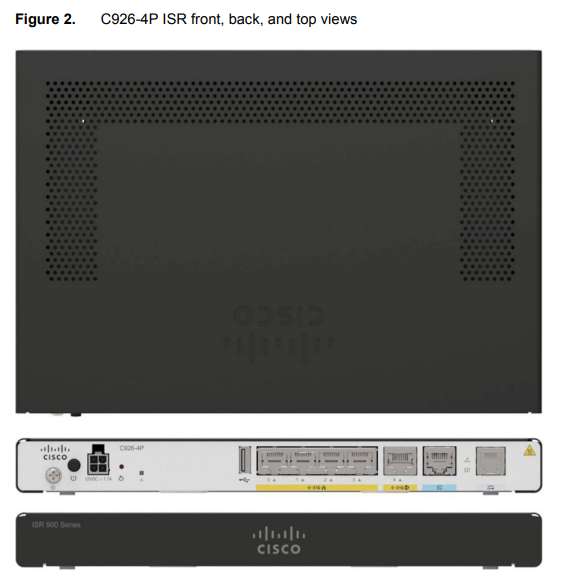
The new Cisco 900 series Integrated Services Routers are the SOHO routers that offer unmatched throughput levels.
- The 900 Series ISRs are available in fixed form factors.
- The Cisco 900 series is best suited for small and midsize businesses, enterprise branches and as customer premises equipment in managed services environments.
- The Cisco 900 Series ISRs deliver integrated security and threat defense, protecting networks from both known and new Internet vulnerabilities and attacks. These powerful, fixed-configuration routers provide secure broadband and Metro Ethernet connectivity. Service providers offering managed Ethernet WAN services can deploy them in customer locations as CPE. Centralized and remote management capabilities are available through web-based tools and Cisco IOS Software for full visibility and control of network configurations at the remote site.
- The 900 Series ISRs simplify the deployment of Ethernet WAN services, with end-to-end Operations, Administration, and Maintenance (OA&M), Service-Level Agreement (SLA) monitoring and verification, and configuration management.
- The Cisco 900 Series ISRs come with a 4-port managed switch, providing LAN ports to connect multiple devices.
Cisco 900 Series Integrated Services Routers-Hardware, Software, Security Features
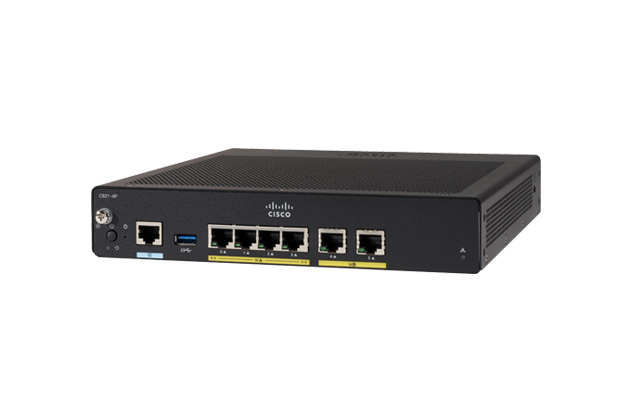
Base models of the Cisco 900 series ISRs
| Model | Switch Ports | WAN Ports | Console Ports | DSL |
| C921-4P | 4 | 2 | 1 | None |
| C921J-4P | 4 | 2 | 1 | None |
| C931-4P | 4 | 2 | 1 | None |
Cisco 900 Series–Hardware Features
The 900 Series ISRs are fixed-configuration, integrated services routers. These routers offer numerous variants for different WAN (Ethernet, DSL, LTE) and LAN (Ethernet) connectivity options. You must carefully consider your requirements to support a network deployment before you place an order.
- The 900 Series ISRs are fixed-configuration, integrated services routers that do not have hardware upgrade options.
- The 900 Series ISRs have two GE WAN ports. The DSL variants have one GE WAN port.
- The 900 Series has four Gigabit Ethernet switch ports.
- A Single USB 2.0 port is available on the 900 Series ISRs for flash storage.
- The reset button is used to restore the router to factory default settings if pressed within five seconds of router power up.
- The 900 Series does not have an auxiliary port, It has a single RJ45 console port.
- The 900 Series is fanless. It is passively cooled and is noiseless.
- All 900 Series routers have two GB of Flash and one GB of DRAM. They cannot be upgraded.
The platform power specifications for the ISR 900 Series
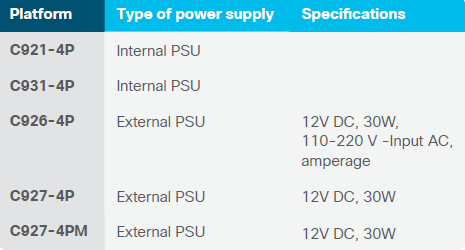
Cisco 900 Series-Software Features
- The 900 Series ISRs support Cisco IOS Software Release 15.8(3) Mb.
- The 900 Series ISRs support a single universal image. A universal image includes all features supported by a given platform.
Three major technology licenses are available on the 900 Series. These licenses can be activated through the Cisco software activation process. The following licenses are available:
- IP Base-this technology package is available as the default.
- Application Experience (APP)-this license includes data and application performance features.
- Security (SEC) or Security with No Payload Encryption (SEC-NPE)-this license includes features for securing network infrastructure.zz
During the router reload process, the 900 Series ISR automatically searches for a bootable Cisco IOS Software image on the USB flash memory f no bootable image is available on the onboard flash memory.
- A Cisco IOS Software configuration file can be booted from the USB flash memory only if the Cisco IOS Software command—boot configusbflash0:—is part of the router startup configuration stored in NVRAM.
- You can configure and manage the 900 Series ISRs with Cisco Configuration Professional.
- The performance with services for the 900 Series ISRs is 250 Mbps.
- The 900 Series ISRs support Cisco Virtual Office. Support is on the roadmap.
- The 900 Series ISRs DO NOT support Cisco Wide Area Application Service Express (Cisco WAAS Express).
- The 900 Series ISRs DO NOT support Cisco ScanSafe.
Cisco 900 Series-Security Features
The hardware-based encryption is available on the 900 Series ISRs. Hardware-assisted IP security (IPsec) Triple Data Encryption Standard (3DES) and Advanced Encryption Standard (AES) encryption is available on the 900 Series ISRs; 128-, 192-, and 256-bit keys are supported for AES.
- The 900 Series ISRs support 100 IPsec tunnels.
- The 900 Series ISR support basic security features such as site-tosite VPN, Easy VPN, DMVPN, Group Encrypted Transport VPN, and application inspection and control with Cisco IOS Firewall.
- The 900 Series ISRs provide un-throttled performance for unencrypted traffic.
Check Table1 for the maximum crypto throughput.
Table1. Platforms and throughput
| Platform | Maximum crypto throughput (bit-rate policed) |
| C921 | 150 Mbps |
| C931 | 250 Mbps |
| C926 | 150 Mbps |
| C927 | 150 Mbps |
Cisco 900 Series-DSL Features
The 900 Series ISR platforms support DSL technologies listed in Table2.
Table2. DSL Technologies supported by the 900 Series
| Model | DSL technology | Minimum Cisco IOS
software release requirement |
| C926 | Multi-mode
xDSL Annex B/J (ADSL1/2/2+ Annex B, less-optimized Annex2/2+ J[1], VDSL2 over ISDN band plans) |
15.8(3)M1 |
| C927 | Multi-mode xDSL
Annex A, (ADSL1/2/2+ Annex A, lessoptimized ADSL2/2+ Annex M, VDSL2 over POTS band plans) |
15.8(3)M1 |
| C927-4PM | Multi-mode xDSL
Annex M (ADSL2/2+ Annex M, lessoptimized ADSL/ ADSL2/2+ Annex A, VDSL2 over POTS band plans) |
15.8(3)M1 |
The 900 Series ISRs support both ATM and Ethernet Packet Transport Mode (PTM).
The 900 Series can support:
Table3. VDSL profiles and throughput
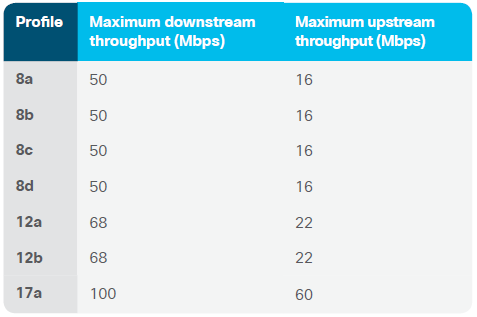
Table4. ADSL profiles and throughput
| Version | Standard name | Common name | Downstream rate | Upstream rate |
| ADSL | ANSI
T1.413- 1998 Issue 2 |
ADSL | 8.0 Mbps | 1.0 Mbit/s |
| ITU G.992.1
Annex A |
ADSL over
POTS |
12.0 Mbps | 1.3 Mbit/s | |
| ITU G.992.1
Annex B |
ADSL over
ISDN |
12.0 Mbit/s | 1.8 Mbit/s | |
| ADSL2 | ITU G.992.3
Annex L |
RE-ADSL2 | 5.0 Mbit/s | 0.8 Mbit/s |
| ITU G.992.3 | ADSL2 | 12.0 Mbit/s | 1.3 Mbit/s | |
| ITU G.992.3
Annex J |
ADSL2 | 12.0 Mbit/s | 3.5 Mbit/s | |
| ADSL2+ | ITU G.992.5 | ADSL2+ | 24.0 Mbit/s | 1.4 Mbit/s |
| ITU G.992.5
Annex M |
ADSL2+M | 24.0 Mbit/s | 3.3 Mbit/s |
Yes or No?
Q: Does the Cisco 927-4PM ISR support the Persistent Storage Device (PSD) mask required to comply with the Annex M standards in the United Kingdom?
A: Yes.
Q: Do the 900 Series ISRs support extended Impulse Noise Protection (INP) functions?
A: Yes.
Q: Is Ethernet First Mile (EFM) bonding supported?
A: No.
Q: Does the 900 Series support both ATM and EFM?
A: Yes.
Q: Is dying gasp supported?
A: Yes, the Customer Premises Equipment (CPE) can send a message to the central office equipment managed by an Internet service provider or Digital Subscriber Line Access Multiplexer (DSLAM) to indicate that the CPE has lost power.
Q: Can DSL modem firmware be upgraded on the 900 Series?
A: Yes, DSL modem firmware can be independently upgraded on the 900 Series ISRs. Instructions to upgrade modem firmware can be found in the software configuration guide.
For more information on the features and specifications of Cisco 900 Series Integrated Services Routers (ISRs), refer to the Cisco 900 Series Integrated Services Routers datasheet.
More Related:
Migrate to ISR 4000 Series Now
ISR4221/K9 and C1111-8P Replace the Hot Cisco 1941 and 1921 Routers
Cisco 4200 Series/ISR 4221-A Router Built for SMB Networking
More Cisco Router Topics you visit here: https://blog.router-switch.com/category/reviews/cisco-routers/


